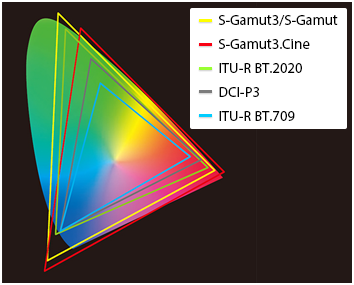Gamut
While color space is a concept used to describe colors geometrically in a three-dimensional space, the area supported by a device within this color space is called its gamut.
By determining three points – red (R), green (G), and blue (B) – that a device supports within an XYZ space as shown here, we can plot an RGB triangle with the points as vertices. Through additive color mixing of R, G, and B, the device can reproduce all colors in the RGB triangle. An area like this, enclosed by the RGB triangle, is the device's gamut.
For cameras, displays, and other imaging devices, gamuts vary depending on the characteristics of the components and image processing circuits. Devices with wider gamuts can reproduce more saturated colors.
Commonly used gamuts include ITU-R BT.2020, DCI-P3, and ITU-R BT.709.

When shooting in S-Log3, you can choose either S-Gamut3.Cine or S-Gamut3 as the gamut.
S-Gamut3.Cine
Designed to resemble scanned negative film, S-Gamut3.Cine covers a slightly wider area than DCI-P3, for easy post-production editing. This makes color correction for DCI-P3 applications easier than with S-Gamut3.
S-Gamut3
S-Gamut3 covers an even wider area than S-Gamut3.Cine – the widest a camera can capture. S-Gamut3 is a good choice for conversion to ACES or ITU-R BT.2020 and is ideal for archiving purposes.

